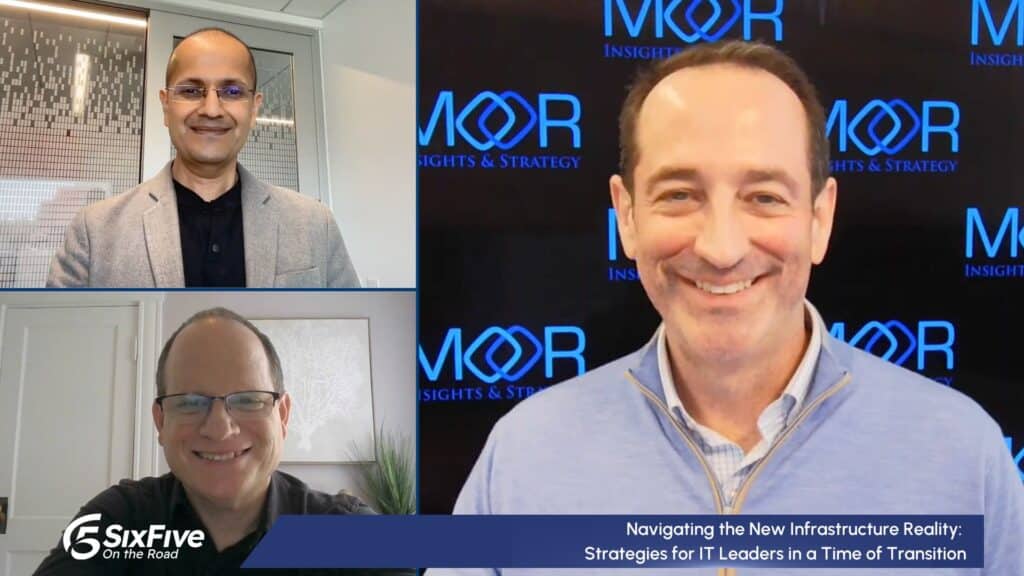On this episode of the Six Five On The Road at Computex Taipei, hosts Olivier Blanchard and Anshel Sag are joined by ASUS‘s Benjamin Yeh, President of North America, System Business Group, for a conversation on ASUS’s innovative strategies and the future of AI PCs.
Their discussion covers:
- The distinctiveness of the ASUS Vivobook S 15 from previous ASUS designs and innovations
- The advantages of ASUS’ partnership with Qualcomm in developing the latest generation of CoPilot+ PCs
- The future direction for AI PCs, as seen through the lens of ASUS’s current CoPilot+ PC offerings
- Prospects of integrating CoPilot+ technology into ROG-based PCs and the potential focus on non-gaming systems
Learn more at ASUS.
Watch the video below, and be sure to subscribe to our YouTube channel, so you never miss an episode.
Or listen to the audio here:
Disclaimer: The Six Five Webcast is for information and entertainment purposes only. Over the course of this webcast, we may talk about companies that are publicly traded and we may even reference that fact and their equity share price, but please do not take anything that we say as a recommendation about what you should do with your investment dollars. We are not investment advisors and we ask that you do not treat us as such.
Transcript:
Olivier Blanchard: Welcome back to Six Five On The Road at Computex this week. I’m Olivier Blanchard and with cohost Anshel Sag, and we’re here today talking with Benjamin Yeh, let me get this right, ASUS’ Computer President North America Systems Business Group. Welcome. Thanks for joining us. And I guess we’re going to be talking a little bit about the Snapdragon X Elite platform. And I know that Anshel has a question that he’s been dying to ask you, so I’ll just let him start.
Anshel Sag: Yeah. So ASUS has been really known for taking risks in our industry and aggressively innovating on design and form factor. So how is the ASUS Vivobook S15 different from other ASUS’ endeavors in the PC space?
Benjamin Yeh: Got it. Thanks for the question. So in ASUS, we are very proud of our engineering capabilities and we have more than one third of our employees worldwide, our engineers. So we’re trying to bring innovation to market like the first 2-in-1 laptop, the first netbook decades ago, and the first dual-screen laptop. We just launched Zenbook DUO also last year. So the latest Vivobook S15 Snapdragon device, basically this is our first Copilot+ PC.
So we launched it together with Microsoft and Qualcomm, and basically has a full gen AI feature. And also at the same time, instead of keeping the product at a super high price point, we keep it as more mainstream so that everybody can enjoy the device and so everybody can benefit from the Copilot+ AI features. So basically that’s what we have. So we are starting from 1299, so quite a mainstream price point for the latest innovation. And it has the 3K OLED screen. And so it just look fantastic. And also it has more than 16 hours battery life, so let’s say a full-day computing capability. So yeah, that’s what we say we’re having right now.
Olivier Blanchard: Okay. So you’ve had a longstanding relationship with Qualcomm, so how has that been an advantage in developing these new Copilot+ PCs for you guys?
Benjamin Yeh: Yeah. So ASUS, we not only produce laptop and desktop, but we also have our phone business and we have products across all different platforms and different technologies. We started our partnership with Qualcomm more than a decade ago. So I think it’s 2008 we were working with Qualcomm to launch our first Qualcomm-based tablet device and also starting from Zenfone 3, our smartphone, the third generation smartphone. And so that was, I think we launched it in 2016, and that’s what they say ever since we’ve been working with Qualcomm for the latest phone that’s a smartphone with the latest Qualcomm processors in more than a decade.
So working with Qualcomm in different product categories and even platforms, that enabled us to understand their architecture, to understand their technology much better. So we are very familiar with their products, with their devices and the perfect balance between performance and battery life and multi-task capabilities. And so that helps us to launch the latest devices and also embedded with all the different features.
Olivier Blanchard: So you have quite a few new Copilot+ PCs out in the market. And I’ve been wondering in terms of differentiation and trajectory for the ASUS brand, where do you think AI PCs and specifically through Copilot+ PCs, where do you think things are going next for the market and also specifically for you guys?
Benjamin Yeh: Got it. I mean, at the end of the day, all PC will be AI sooner or later. Well, sooner than later. So this year we are looking at, well, every company or every person has their own definition of AI PC. But if we define AI PC as the capability for the generated AI capabilities and also to help these people to finish their task in a different way, in a revolutionary way, I think this single digit in the market will be so-called the AI PC, but within three years it will have gone to a good double-digit. And then afterwards obviously all the PCs will be AI.
First for ASUS, let’s say because we have many different hardware devices and also we have many different solutions, we have edge AI and we have cloud AI, we have client AI devices and we work with different vendors and different partners, so we believe that with our innovation capability, we can bring the best combination of AI devices to the market.
Anshel Sag: So I was wondering, do you foresee? I’m a big gamer, so I was curious if you see any ROG-based, Republic of Gamers Copilot+ PCs coming from you guys anytime soon? Or do you see Copilot+ PCs mostly as non-gaming systems, even though I think I saw a TUF system announced yesterday?
Benjamin Yeh: Yep. And so let’s say together with Qualcomm right now or let’s say with the Snapdragon on our roadmap, we currently are not releasing any gaming-based devices for Copilot+ PC. But then please stay tuned and we have a lot of different devices announced now and also in the future.
Anshel Sag: Great. And I also wanted to talk to you about the ASUS event happened yesterday, and you guys had a multitude of systems announced, but the one really interesting system that I was excited about was the PZ13, which is a really interesting concept where it’s both a creative device, it’s also a tablet and it’s a rugged device and it has a Snapdragon X Elite inside of it. So could you maybe tell us about how you guys arrived at such a device and maybe where you guys thought that this was a perfect fit for the market because I wasn’t expecting to see a rugged tablet out of ASUS, and I’m just curious to see what you think.
Benjamin Yeh: So Pro laptop is a new category we are going to bring to the mainstream market this year. And so in Pro family we have a regular clamshell laptop and we have a convertible laptop. And then the most importantly, we work with Qualcomm for the Snapdragon based tablet. It comes with IP52, so it’s a rugged device. And basically the whole Pro family, what we are looking at is for the creators on the go. So the creators, when they are on the road, and if they just have some kind of idea, they want to do something with that idea, with a specific idea, they can just do it anytime, anywhere. And together with Snapdragon, Copilot+, a PC feature they can just generate the content they want and they need at that specific moment and without any boundary. And so for that purpose, we believe a tablet is a perfect platform to serve this kind of scenario.
Anshel Sag: Yeah, that makes perfect sense. It’s like instantaneous creativity paired with AI, which accelerates that instantaneous creativity into something even bigger.
Benjamin Yeh: Yep. And we embed our Pro Series with ASUS proprietary softwares, different AI softwares, and that will just complete or complement the whole AI experience.
Olivier Blanchard: So Benjamin, thank you so much. Unfortunately that’s all the time we have left. So on behalf of Anshel and myself, thanks a lot for watching. Stay tuned. There’s a lot more content coming. But don’t forget to hit that subscribe button, follow us on all of our social channels and don’t go too far because we’re coming back with a lot more coverage of Computex.
Author Information
Olivier Blanchard is Research Director, Intelligent Devices. He covers edge semiconductors and intelligent AI-capable devices for Futurum. In addition to having co-authored several books about digital transformation and AI with Futurum Group CEO Daniel Newman, Blanchard brings considerable experience demystifying new and emerging technologies, advising clients on how best to future-proof their organizations, and helping maximize the positive impacts of technology disruption while mitigating their potentially negative effects. Follow his extended analysis on X and LinkedIn.
Six Five Media is a joint venture of two top-ranked analyst firms, The Futurum Group and Moor Insights & Strategy. Six Five provides high-quality, insightful, and credible analyses of the tech landscape in video format. Our team of analysts sit with the world’s most respected leaders and professionals to discuss all things technology with a focus on digital transformation and innovation.











